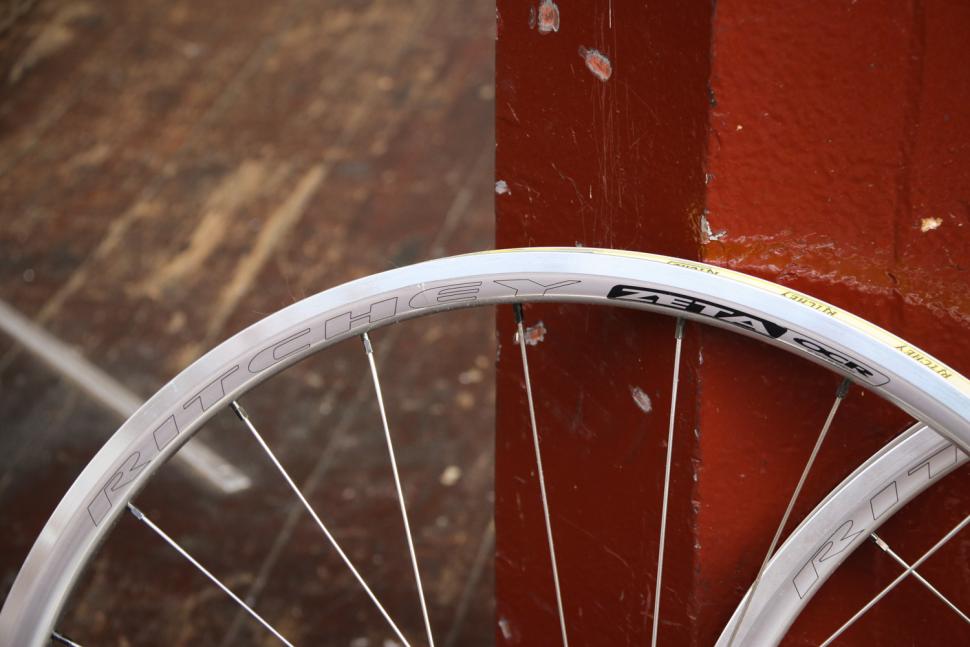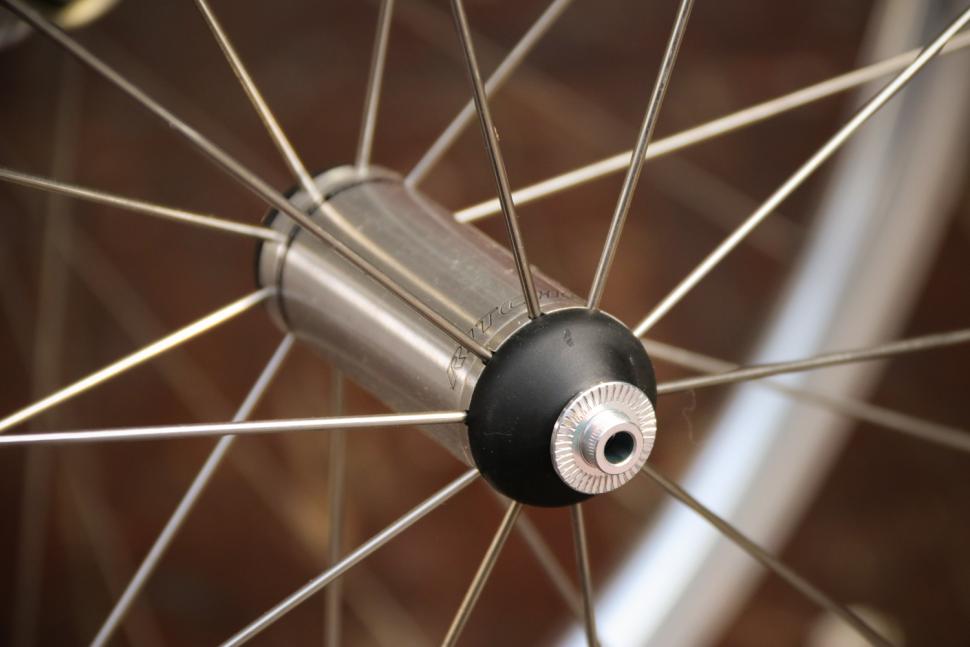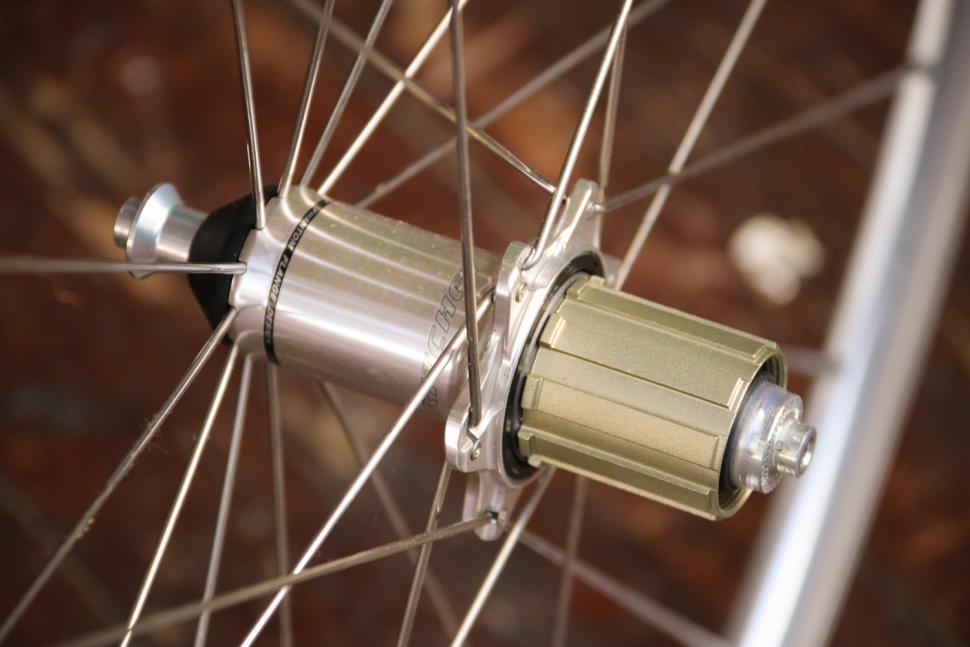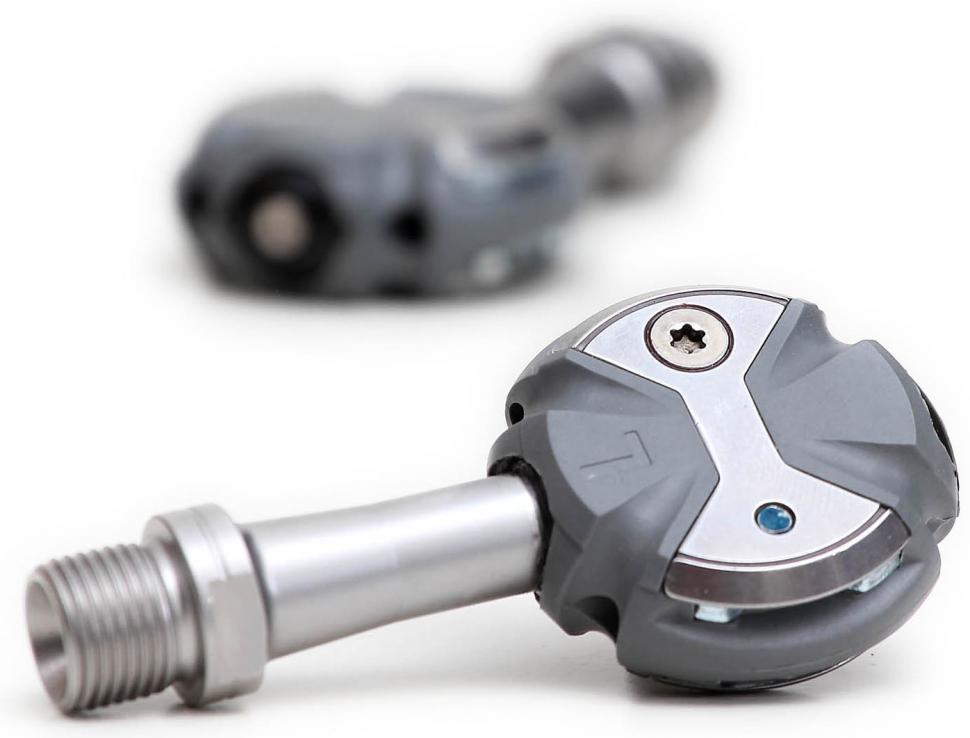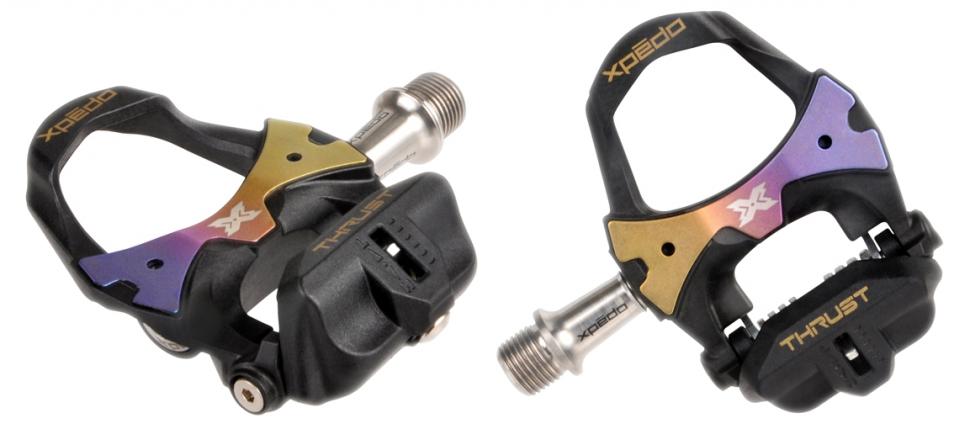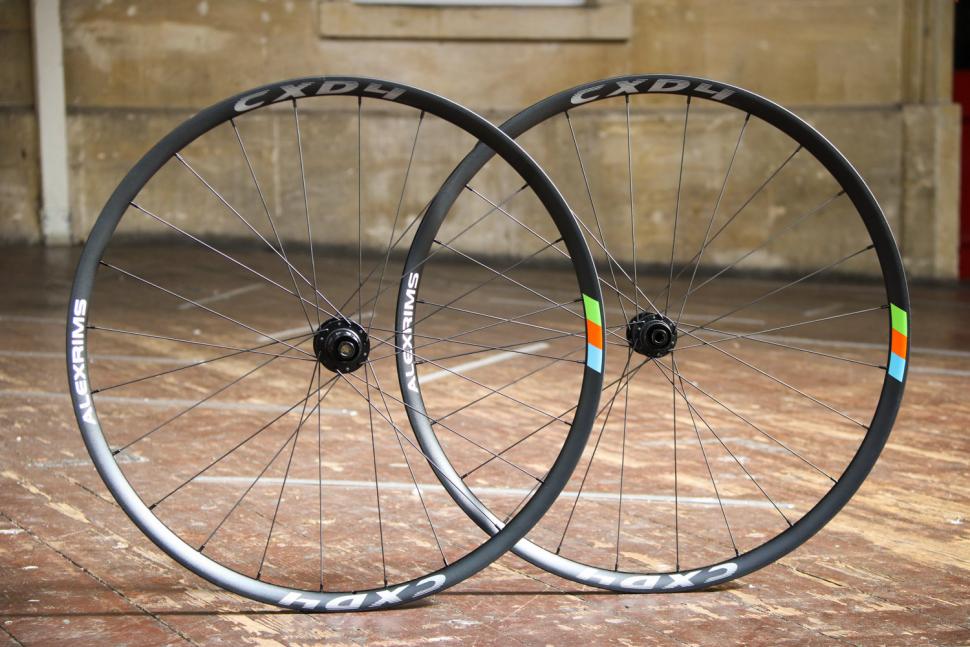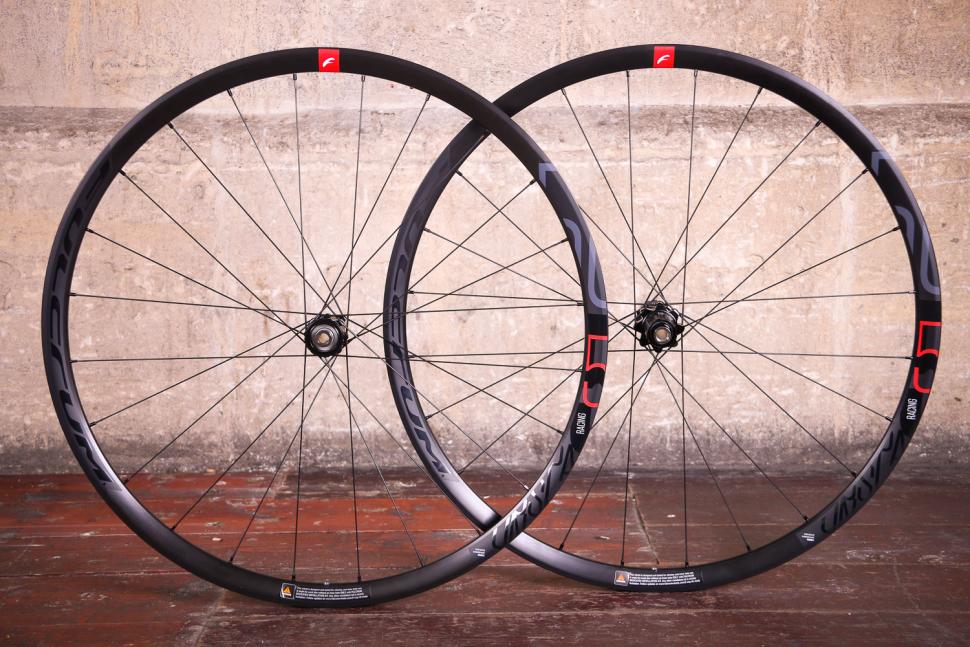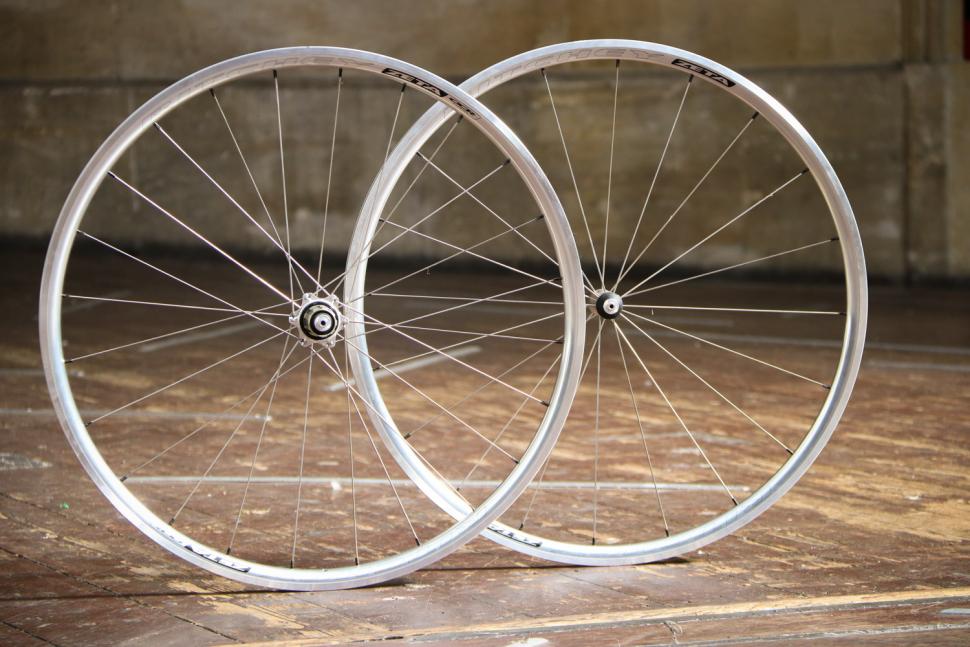Tubeless wheelsets have become way more common recently, particularly since more tubeless tyre options arrived on the scene, and here are some of the very best that we've reviewed for under a grand.
A tubeless system is basically a clincher tyre inflated onto a rim with no inner tube. Instead of an inner tube holding the air pressure, an airtight chamber is created with a tubeless-specific tyre, developed with a special (commonly carbon) bead, and a compatible rim.
The main advantage is the substantially reduced risk of puncturing if you use liquid sealant inside the tyre. This sloshes around inside and reacts with air if the tyre casing is punctured, and plugs the hole. It can seal most small holes caused by flint or thorns and while you might suffer a small drop in pressure, you can continue riding.
If you want to go tubeless you need the right wheels, and here are 23 of the best, some for rim brakes and some for discs.
Clicking on the heading of each wheelset will take you to a dealer.
Scribe has delivered a double whammy with its Race wheelset. Not only are they light enough to compete with similar depth carbon fibre wheels, they'll cost you at least half the price. And to achieve the numbers on the scale, Scribe hasn't sacrificed on strength or stiffness either.
If you're searching for lightweight wheels as a general upgrade for riding or even racing, carbon fibre rims are typically the go-to option. But the Scribe Race wheels show that you can have pretty much all of the performance and stiffness of carbon in alloy guise without the price tag.
For your £360 you're getting a set of wheels that weigh just 1,492g (without rim tape), and under hard acceleration or sprinting up short, sharp climbs the Scribes don't flex at all, so brake rub isn't an issue. Scribe has achieved this performance by using a hardened, heat-treated alloy for the rim design.
Read our review of the Scribe Race
If you ride a lot on gravel tracks and trails you want a wheelset that can take plenty of abuse, and these Hunt 4 Season Gravel Disc X-Wide wheels fit that bill brilliantly. They're solid, dependable and lovely wheels to ride, and with their wide rim bed they work perfectly with wider gravel tyres.
The 4 Seasons have a very solid feel to them, which also gives a sense of comfort. The rim depth is only 19mm, so you don't get any of the harshness sometimes found on deeper section alloy or even carbon rims.
I've got some steep descents on my local gravel tracks where 50mph is achievable, and while they are reasonably hard packed there are some cruel rocks to catch you out as the aggregate blurs past beneath you.
Sometimes the bunny hops aren't quite high enough and I whacked a large stone that was about 8in in diameter at speed. The sound was deafening, and I really thought I'd totalled the rear wheel.
There was dust and a mark on the tyre and a bit of a scratch to the finish of the wheel where the impact had taken place, but everything was still spinning as true as it was when I took them out of the box. I was very impressed.
Read our review of the Hunt 4 Season Gravel Disc X-Wide
The 30 Carbon Aero Disc wheelset from UK brand Hunt is unbelievably light, which really benefits climbing and acceleration, especially because achieving that weight hasn't meant any loss in lateral stiffness. These are seriously good wheels at a very good price.
With 30mm-deep rims, these wheels are versatile for all kinds of road riding – racing, sportives, audax or just getting out with mates on a group ride.
At just 1,347g they feel light and responsive whatever the terrain, but it's most notable when you are in the hills. Attack a climb out of the saddle and they'll make the whole bike surge forward as if it weighs nothing, also helped by the instant engagement of the multi-point pawls in as little as 7.5 degrees.
It's the same when it comes to sprinting or hard acceleration: the response is like a switch has been flicked bunging another 100 watts into your legs for free.
All of this is a waste of time if you can't get that power out because of flex, but there are no such issues here. Even full-on sprinting efforts don't see the rims budge a millimetre from side to side.
Read our review of the Hunt 30 Carbon Aero Disc Road wheels
In developing the Aero Wide 38 wheels, Scribe has shown that while the disc brake continues to grow in popularity there is still plenty to be done for those of us who prefer rim brakes to stop our bikes. Weighing just 1,401g without sacrificing stiffness, these wheels are fast, hugely versatile and they come in at an impressive price.
Taking them out of the box, the first thing you notice is the weight – or lack of it – which can often give a little bit of trepidation before fitting them to the bike.
I'm not your typical whippet-thin racer and I can put out a lot of power in quick bursts for short, sharp hills or sprinting for lights, that kind of thing, and if a wheel designer has focused on weight rather than lateral stiffness, I'm going to notice it.
When riding the Aera AR55 wheels I could get them touching the brake pads even when they were backed off by millimetres, but thankfully hitting the same climbs on the Scribes hasn't seen a single issue even with pads sitting a millimetre away from the rim.
Acceleration is epic, and when you are riding in unfamiliar places and don't know what is around the corner, finding yourself at the foot of a hill isn't an issue as just a quick dig on the pedals or climb out of the saddle will see the wheels maintain pace much easier than a heavier set.
Read our review of the Scribe Aero Wide 38 wheels
Back in 2015 Stu rated the Mason Resolution featuring the first 17mm-internal-width incarnation of the collaboratively designed Mason x Hunt 4 Season Disc wheelset. He found that 'stiffness is high, you can really notice that when sprinting or climbing out of the saddle yet they don't feel harsh in any conditions'. The second incarnation is also a cracking buy.
At launch in 2015, the Mason X Hunt 4 Season wheels were £349. The 2019 update brings the width out to 19mm, allowing wider tyres and the multiple benefits thereof, for a price of £329. That's about a £55 reduction allowing for 2015-2019 inflation – not bad for a product that's only improved technically.
On the road over three months – be it gravelly, rocky or tarmac – the Mason X Hunt 4 Season Discs didn't disappoint. They felt solid, with no discernible flex likely to create tyre rub if you're pushing the limits of your frame clearance. Talk of 'stiffness' or 'comfort' is pretty much moot with large, soft tyres – so let's just say that the 4 Seasons felt great, steering was sharp under cornering/braking, and the 4-pawl 10-degree engagement freehub felt snappy when accelerating hard. The ratchets are on the loud side, so if you're after stealth maybe look elsewhere. The freehub body is coated with a special treatment that Hunt says provides 'excellent durability against cassette sprocket damage'. Removing my cassette after a fair bit of riding, I couldn't see any sign of wear at all – so it's obviously working.
Read our review of the Mason X Hunt 4 Season Disc Wheels
The Hunt 35 Carbon Gravel Disc X-Wide are the UK brand's flagship gravel wheelset. The step up to 23mm internal rim width sets them up for the new breed of mega-wide-clearance allroad bikes – and the adaptable hubs mean your investment now is almost guaranteed to fit any future bike purchase.
Out of the box the X-Wides look quite the business – jet black with subtle white branding. With an outside width of 30mm and depth of 35mm (hence the name) they look huge – but at only 1.5kg for the set, there's clearly carbon witchcraft going on inside.
The main reason for getting the X-Wides is the super-wide 23mm rim bed, backed up by a few square acres of carbon chunkiness to keep things in one piece. There's a great deal of comfort to be had from the rim profile when you're bombing about taking drop bars where no sane person would consider sensible or even possible. Everything about the X-Wides murmurs 'Find Your Limits', and it didn't take me long to trust that they were more than up to the job.
Setting up my now-40mm Steilacooms for about 32psi, no byway or gravelly road was beyond them. I sought out increasingly-lumpy mountain bike trails and footpaths (perfectly legit up here in the Bonnie Republic), the only limits to hand being my own skills and willingness to risk considerable personal pain should things go awry.
The pre- and post-gravel commutes on tarmac amply demonstrated the X-Wides' ability to hold a decent turn of speed, even in a nippy crosswind. Obviously the asymmetric profile is going to favour wind from one direction over another, but I couldn't work out which, even battling along a snaking road over a North Yorkshire moor. No doubt the aero butted spokes help out here, keeping things swishing along.
Read our review of the Hunt 35 Carbon Gravel Disc X-Wide wheels
Pacenti's Brevet Wheelset offers a classic look with modern features and performance that exceeded our expectations. The weight is good, but this is a wheelset all about comfort and style, both of which Pacenti has got spot on.
Ever since carbon wheelsets rudely made an appearance in Paris-Roubaix, my love of a classic box-section rim has grown ever stronger. These days, Enves are more common on the club run than a classic, handbuilt wheelset and that saddens me. I've owned many shallow section wheels, the best of which were Ambrosio's Excellence rims laced with plain gauge spokes to blissfully silent Ultegra 6800 hubs.
Pacenti markets these wheels as classic style matched with modern features, intending them to be used for a retro bike build that you can take to L'Eroica. What I see is a stylish set of wheels for getting the miles in.
The classic style is the main feature for me, and wow do these look stunning. The polished box-section alloy rims are just 15mm tall and have 28 spoke holes holding silver Sapim D-Light J-bend spokes. These attach in a two-cross lacing pattern to the high-flange hubs.
Read our review of the Pacenti Brevet Wheels
The Scribe Aero Wide 50-D carbon disc wheels are all about speed according to the manufacturer, and they don't disappoint. Matching a wind-cheating 50mm-deep rim to smooth-running hubs, an instantaneous freehub engagement and plenty of stiffness makes for a set of wheels that delivers for those who want to put the hammer down. The impressive weight and a sensible price finalise the deal.
A wheel weight of 1,449g (1,438g claimed) is impressive full stop, but when you consider that's including a wide and deep carbon fibre rim, plus the extra spokes needed for a disc build, it is truly awesome and something you really notice when fitting them to your bike.
I've got another test bike that's wearing a set of Campagnolo Bora 50 Disc wheels, which are pretty old school: a narrow rim and that V-shaped profile I mentioned earlier. Fast yes, but much more twitchy in a crosswind compared to these Scribes.
The Scribes do offer quite a firm ride, although I wouldn't say they are overly harsh, and if my focus was more on speed anyway then I'd be willing to sacrifice a bit of comfort.
Read our review of the Scribe Aero Wide 50-D wheels
The Pacenti Forza-C 30mm Disc Clincher wheels are a new design from the ground up and they are absolutely lovely. You can feel the quality of the build as soon as you start riding, and their stiffness is impressive considering their very svelte 1,378g weight. Pacenti hasn't even stung you on the price either.
Pacenti builds these wheels by hand in the UK and it shows – not necessarily the UK bit, but definitely the handbuilt part. The wheels feel tight and stiff, but the spoke tension allows enough comfort through to take out any harshness.
The tyres will obviously do the majority of this, but using the same tyres, pressures and so on between the amount of wheels I get through, you can feel the tiny little differences.
Speaking of tyres, the Forza-C rims are hookless so they are only compatible with proper tubeless tyres, none of that tubeless ready stuff, so that might limit their appeal somewhat to prospective purchasers. You can fit an inner tube if you like, as long as you use a tubeless-specific tyre.
Read our review of the Pacenti Forza Carbon Disc wheels
Pacenti has delivered an excellent product with its Forza Rim Brake wheelset, marrying an impressive weight with a solid, do-it-all road rim for racing or training – all for a very reasonable price, even against the biggest brands in the marketplace.
While it might feel like every wheel brand is pushing its latest disc brake offerings, it can be easy to think that rim brake wheelsets are being left behind, but thanks to brands like Pacenti there are still some quality offerings out there – like the Forza.
Tyre widths have been increasing in the road genre over the last few years and rims have been getting wider too, to keep the compatibility. Rim brake frames don't have the clearance of disc brake versions, because of them needing to keep the brake bridge for one thing, so the Forza rim isn't the widest we've seen at 24mm externally (20mm internal). Pacenti does say that it works perfectly with a 25mm tyre and I'd concur, as it gives the tyre a nice round profile rather than that lightbulb shape you get when used with a more traditional rim that is 3mm narrower.
Read our review of the Pacenti Forza wheels
The Parcours Grimpeur Disc wheels are light enough to excel on the tarmac while being so tough that you can smash them over rocks and tree roots with little concern for their wellbeing. They won't break the bank either.
With a 40mm-deep U-shaped carbon rim they weigh in at just 1,406g with the tubeless rim tape fitted, which ties in well with Parcours' claimed weight of 1,390g bare.
Fitted to the Flanders Forte cyclo-cross frameset that we had in for testing, the wheels offered snappy acceleration, and their low weight helped the whole bike feel flickable at the front and rear for hopping over potholes, rocks and other obstacles.
Obviously, being fitted to a cyclo-cross bike they spent most of their time off-road and they took the knocks and bumps from the gravel tracks and tree roots of the local singletrack without issue.
Parcours has gone for a build of 24 Sapim CX-Ray spokes front and rear in a two-cross lacing pattern which certainly feels stiff and gave no issues with trueness even after a fairish amount of abuse. Hard acceleration and heavy braking did little to upset them either, from a stress point of view.
Read our review of the Parcours Grimpeur Disc wheels
The Lark Light Road wheels from UK brand JRA (Just Riding Along) certainly live up to their name, weighing just 1,460g for the set. They're very responsive and JRA hasn't sacrificed durability to save the grams either. It's the perfect package for the rider who wants a classically styled, lightweight set of wheels for racing or training.
I was massively impressed with JRA's Gecko Carbon wheels when I tested them. They offered a solid build while being extremely lightweight and that theme is followed here with the Lark Lights.
Losing 250g from a wheelset always seems, to me anyway, to make much more of a difference to how the weight of the bike feels compared with dropping the same amount elsewhere, so swapping to the Larks from a set of winter rims made impressive differences to acceleration and climbing.
The JRA Light Road hubs run very, very smoothly on their stainless bearings and the pick-up on the freewheel is fast and precise, which all adds to effortless rolling whether on the flat or rolling terrain.
Read our review of the Just Riding Along Lark Light Road wheels
Prime's BlackEdition 50 Carbon Wheelset represents the brand's first push to compete with high-end performance wheels. They vastly outperform their price tag, with stable rims, great braking, smooth hubs and easy tubeless setup.
If you're not familiar with Prime, its a brand sold exclusively through Wiggle and CRC. Wiggle is using its buying power to produce a very capable race wheelset at a much better price than many well-known brands.
In the box, you get tubeless valves, carbon brake pads, QR skewers, spare spokes, nipples and a 10-speed spacer. They don't come with sealant, but that's something I'd get when selecting tyres.
The 50mm deep rim brake option on test can be run using both clincher and tubeless tyres. They arrived with Hutchinson's Fusion 25mm tubeless tyres fitted, but I also tested them with Vittoria's 25mm Corsa G Tubeless and 28mm Goodyear Eagle tubeless tyres. All were easy to mount up with a standard track pump.
Read our review of the Prime BlackEdition 50 Carbon Wheelset
The CXD4 is an excellent mid-level alloy disc wheelset that's available in 6-bolt or Centerlock configurations. Weighing in at a very reasonable 1,580g, it's a chunk lighter than stock wheels you'll find on most bikes under about £2,000.
The rim is a tubeless-ready 23mm alloy extrusion, sleeve-jointed for extra strength. The rim shape is asymmetric to better balance the spoke forces, with the same rim being used front and rear. At the front the spoke holes are offset away from the disc side, and at the rear they're offset towards it, as the freehub moves the hub flange in more than the disc does.
Both front and rear are built up with 24 round stainless steel spokes in a two-cross pattern. The hubs have an alloy body and axle and sealed cartridge bearings.
We had these wheels set up with 30mm Schwalbe G-One Speed tyres for the duration of testing. Getting them to seal wasn't a problem and we had no issues with the tyres losing air more than normal.
On the road the wheels feel nice and stiff, with no obvious flex either from sprint efforts or heavy cornering. The bearings run smoothly, and whipping the cassette off showed that there's not very much notching on the alloy freehub body.
Read our review of the AlexRims CXD4 wheels
Find an AlexRims dealer
The Racing 5 is a well-established wheelset, available in both disc and rim brake (£299.99) configurations. It is a decent choice for a first upgrade.
Within the Racing range, the 5 is the general-purpose road wheelset. They're a reasonable weight for the money – we weighed them at 1,640g compared to a claimed 1,610g – which makes them competitive with similar-priced wheels from Hunt and Kinesis, and usefully lighter than Mavic's Ksyrium Disc wheelset.
The rims are asymmetric, which Fulcrum claims "improves rim tension, balancing the forces from brakes and sprocket cassette". If you're after more aero benefits, the similar-priced Racing 4 has a deeper rim, while the Racing 7 is now targeted at all-road use, with a wider rim profile and a higher weight.
The Racing 5 has a 26mm deep rim, which is 21mm wide – wider than wheels were traditionally but not as wide as some. Fulcrum says that it'll take tyres between 25mm and 50mm, making it an option for cyclo-cross too, although it is marketed primarily as a road wheelset.
If you want to run these wheels tubeless you'll need to buy the necessary valves and rim tape because they're not included, which is a bit mean. The Racing 5s should be used only with certain Schwalbe tyres, according to Fulcrum. We can't tell you to ignore that advice... but we did and things worked out just fine.
The hubs are quality affairs, as befits a sub-brand of Campagnolo. They've got sealed bearings and Campagnolo's signature way of reaching them, via a collar with a tiny pinch bolt. They come with various adaptors to suit different axles, from 15mm thru-axle down to a standard QR, and they can be swapped pretty easily as they're just retained with an o-ring friction fit.
The Fulcrums were solidly built, reasonably stiff and generally easy to live with. A lot of disc brake bikes around the £1,000-2,000 bracket will come with relatively heavy wheels as stock, often around 2kg; you'll see a lot of entirely serviceable but quite weighty wheels such as Mavic Aksiums, own-brand hubs with Alex rims and so on. Switching to something lighter like this can save 400-500g; that won't transform the bike, but is enough that you'll notice the difference.
Read our review of the Fulcrum Racing 5 Disc sheels
Find a Fulcrum dealer
Edco's Optima Roches are a tough set of tubeless-ready wheels that are built around Edco's own SuperG hubs. These hubs are guaranteed for a whopping eight years (the other components get a two-year guarantee), a strong hint at Edco's confidence in their durability. They use radial stainless ball bearings and are laced to the alloy rims with 20 Sapim Race double butted spokes on the front and 24 at the rear. You'll need Centerlock disc brake rotors for stopping.
That rear hub has Edco's own MultiSys cassette hub body, making it compatible with both Campagnolo and Shimano/SRAM cassettes. The hub body also has a hardened steel inlay to protect the aluminium body from being eaten by the sprockets.
The rims are wider (24mm) than they are high (22mm), making them bang on the bigger tyres trend. Edco recommends using 25mm tyres. Although the rims are tubeless ready, we found that a bit of perseverance was needed to get them set up,
The Optima Roches stayed perfectly true during testing, despite the fact that we loaded them up for touring over Edco's 110kg maximum weight limit.
These really are about as tough as they come, which is no mean feat for a pair of wheels that weigh 1,725g, have a low spoke count and spin up fast enough to enjoy sprints. They are stiff without rattling the fillings, making them perfect for any kind of riding that requires a fast wheel that will take a battering. Tubes and tyres come as part of the package, and the quick releases are really nice too!
Read our review
Find an Edco dealer
The Ksyrium Elite, Mavic's highly dependable all-rounder, became tubeless in 2018 with the French company's UST system, like much of the range. The wheels are lightweight and durable and are still great to ride whether you are racing or tackling the club run, with a little bit of future proofing.
At 1,532g without tyres the Ksyrium Elite UST wheelset is light enough to be exciting on the climbs or under acceleration, and their stiffness certainly backs that up; you won't get any flex or brake rub here.
You get Yksion Pro UST tyres as part of the package, and they offer loads of grip. Mavic claims that its road UST tubeless system is different from other tubeless systems in that the wheel and tyre are designed together and there's tight control over production variances. Inflation was smooth and simple with the Yksions sitting snuggly against the rim with just the use of a standard track pump, and there were no leaks of sealant anywhere.
If you want a set of wheels to tackle a bit of everything, then the Ksyrium Elites are hard to fault. While you can get cheaper, this is a solid package that'll give you real peace of mind.
The disc version of this wheelset is priced £585.00.
Read our review of the Mavic Ksyrium Elite UST wheels
Find a Mavic dealer
Ritchey has managed to build a tough yet lightweight package with its Classic Zeta wheels and they look the part too with their highly polished silver finish. Whether on smooth tarmac, broken back lane or potholed byway, they roll quickly and aren't shy of taking a knock or two.
What you get here is a pair of 6061 aluminium alloy rims, Phantom Flange hubs connected by DT Competition j-bend spokes and an all-in weight of 1,491g.
The rims have an external width of around 22mm which makes them more suited to larger tyres like 28mm or even Ritchey's own 30mm-wide WCS Alpine JBs, which were used for a lot of the test miles.
Fitting tyres to them is simple: we tried a few brands out and none was a struggle or faff to fit.
Ritchey has specced these Zetas for road, cyclo-cross and light adventure use. Whacking a pothole is pretty much inevitable these days and we smashed through a few on the Ritcheys without issue; they still ran true. They also saw some pretty hard miles on various sizes of gravel, from the small stuff through to bigger, rockier sections. Again, not a single complaint.
Thanks to their low weight, the Zetas perform across the board. Acceleration and climbing feel great as the wheels are just so quick to spin up to speed, and once up there they roll extremely well.
They're comfortable, too, as the handbuilt setup leaves enough give in the spoke tension to keep the wheels stiff for those hard efforts without being an overly harsh ride.
Overall, the Ritcheys are a very good showcase for getting what you pay for, with a great all-round feel of quality, durability and performance. These igh-performance wheels that are just as at home on your race machine as they are on your gravel hack.
Read our review of the Ritchey Classic Zeta wheels
Find a Ritchey dealer
Vision's TriMax 30 KB tubeless-ready wheels are built to last, look great and stay that way thanks to a clever surface treatment. Weight-weenies might find them a shade heavy (we weighed them at 1,570g), but that's far less important than durability and reliability.
They arrived straight and true, and the spoke tension was decent, helping them stay that way. They're laterally stiff enough that we couldn't get them to rub on the brakes, even with the pads positioned close to the rim. They're unaffected by sidewinds because they're only 30mm deep, enough to give them a slight aero advantage over old-school square rims, but not enough to affect handling when it's windy.
Out on the road, the TriMax 30s spin up easily and roll well, and the lateral stiffness of the wide rims – the internal width is 19mm – helps them stay on line in corners. It also bigs up your tyres. Our 25mm tyres ended up more like 27mm across, so we could run a little less pressure for more grip and better cushioning.
Braking is smooth and very powerful thanks to the machined sidewalls and oxide coating which increases friction with the brake pads. This is especially noticeable in the wet.
These are great wheels on a number of fronts: looks, build quality, stiffness, braking, durability and general practicality. They're perhaps overkill if you're a 60kg racing snake, but for those who aren't exactly svelte, the extra beef is very welcome.
Read our review of the Vision TriMax 30 KB wheels
Find a Vision dealer
These wheels feature a ceramic coated rim surface that provides reassuring braking performance in a range of conditions, making them ideal for year-round cycling in the UK.
We rode these wheels for several months in everything from glorious sunshine to freezing rain and everything in between, and they were excellent regardless of the weather.
Braking performance using the supplied brake blocks is very good in dry conditions and is similar to any good aluminium rim. The rims really start to make a case for themselves in rain, mud and grit-coated surfaces, the OXiC coating becoming a benefit with powerful, predictable, and consistent braking.
The other big benefit of a ceramic coating is a rim that is much more durable. Ceramic-coated rims should last for years.
The rims are laced with straight-pull DT aero comp spokes to DT's own hubs with star ratchet internals. They weigh just 1,500g – a little over the claimed 1,472g. Measuring 18mm internally and 22mm externally, they're not as wide as the widest rims currently available, but wider than traditional rims.
DT supplies the sealant and valves you need for running the wheels tubeless, and we found the setup easy.
The hubs feature very wide flanges, intended to increase wheel stiffness, and spin on 240 internals. They are well proven and popular in many aftermarket hubs. The 36-tooth ratchet system in the rear hubs provides very swift engagement when you stamp on the pedals.
These wheels are stiff and responsive, with no give or flex when putting the power down in a sprint or steep climb. The low weight puts many carbon wheels to shame and while they are pricey for an aluminium wheelset, they are a snip compared with most carbon wheels of comparable weight and performance.
For year-round racing, training and just riding, these are excellent wheels with highly impressive braking in all conditions. The appearance, build quality and attention to detail is first class, as is the durability.
Read our review of the DT Swiss PR 1400 Dicut 21 OXiC wheels
Find a DT Swiss dealer
The Just Riding Along (JRA) Gecko Carbon wheelset is very impressive, designed to take on the constant knocks and vibrations the roughest gravel tracks can throw at them, while being so light (1,400g) that they won't hamper your performance on the road. It's also pretty amazing that they come in at well under a grand.
The Geckos are solid. We couldn't detect any feeling of flex on steep, short, sharp climbs, whether on the road or when scrabbling about on loose, large gravel.
The wheels took some big knocks during testing, and while sometimes the noise could be pretty scary, on inspection they had come away completely unscathed, remaining as true as they were out of the box.
The Geckos are built to order and the spoke tension is even throughout. They are comfortable as well, even 25mm tyres pumped up hard never giving a harsh ride.
The full carbon rims have an external width of 27mm and 21mm internal, meaning that tyres tend to size up a little bigger than their sidewall suggests.
JRA has specced Bitex hubs on the Geckos and they are a lovely piece of kit, spinning smoothly and freely.
Overall, the Geckos are excellent wheels for gravel use without being too overbuilt to stop them offering a great performance on the road.
Read our review of the Just Riding Along Gecko Carbon
The BORG50C carbon clincher aero wheels are a sharply priced tubeless-ready option for going fast. Handling well in crosswinds and with an industry-leading lifetime warranty, for the money these are a serious contender for Best Starter Bling Hoops Deal Going.
When the wheels arrived at road.cc they were already shod with IRC's Formula Pro RBCC Tubeless tyres, valves and sealant – that's £910 all-inclusive. The full combo weighed in at 2,520g. Borg sells the BORG50C for £800 naked, which is a very good price for the rounded weight/performance/warranty package.
Malcolm Borg builds his wheels in Suffolk with great attention to detail. Borg promises to replace anything that's failed – rim, spoke or hub – due to a manufacturing defect for the entire life of the wheelset. If you crash them, Borg will repair for the cost of parts only – the labour's free.
Borg has gone for nice Miche Primato Syntesi hubs, with a micro-adjustment ring to take up any play. The rim measures 26.1mm at the aero bulge, and with the 25mm IRC Formula Pro tubeless measuring 23.9mm, there's a definite aero profile going on front to back.
We found it difficult to get some tubeless tyres onto the rim and you need to have a good compressor setup to hand.
The usual concern around 50mm rims is buffeting, but these wheels never got out of hand even when we rode them in strong (20mph+) sidewinds.
during the review period. My rim-braked test frame is a Velocity Selene, a fairly agile responder and therefore commensurately susceptible to external influences.
All in all, for £800 plus tyres of your choice, tubeless-ready and with a best-of-breed warranty and repair service, the BORG50C wheelset is a cracking choice and should be a serious contender for your cash.
Read our review of the BORG50C Carbon Clincher wheels
The 30 Carbon Gravel wheels use a disc brake-only rim design. They're built from unidirectional T24/30 carbon and are 30mm deep and notably lighter than most wide aluminium rims at a claimed 370g. Using carbon helps, obviously, but Hunt has also saved weight thanks to the absence of a brake track and bead hooks.
At 26.6mm externally, and 21.3mm internally, these are wide rims, as befits their intended use, and Hunt says they're suitable for use with tyres from 25mm to 50mm, making them an option for a really broad range of riding.
A healthy 24-spokes at the front and 28 spokes at the rear, laced 2-cross, makes for a really strong, stiff build. Hunt gives a rider weight limit of 115kg for these wheels, and they've shrugged off everything we threw at them, including bridleways, towpath commuting, and touring with panniers on some pretty appalling roads.
The 30 Carbon Gravel wheels are supplied taped and with tubeless valves included. Unlike the majority of road tubeless rims, there are no pronounced bead hooks, just small ridges to keep the tyre beads locked in position. Getting the tyre over the bead hooks is normally the fiddly part of inflating a tubeless tyre, but it's easy here with no bead hooks to get in the way. Using just a track pump, they were sealed within three pump strokes, and needed only a few more strokes to get them fully seated.
The hubs are based on those used in Hunt's 4season disc wheelset with uprated shielding and sealing on the EZO bearings to cope with off-road grot and the occasional jetwash.
It's really hard to find fault with these wheels. Light, wide, rugged and dependable, with genuinely easy tubeless setup, they're exactly what you want from a gravel wheelset. Carbon rims and disc brakes is a great combination, too. If you're in the market for a posh set of wheels for your gravel bike, these are a great option. Hunt has set a benchmark with these superb wheels.
Read our review of the Hunt 30 Carbon Gravel Disc Wheels











